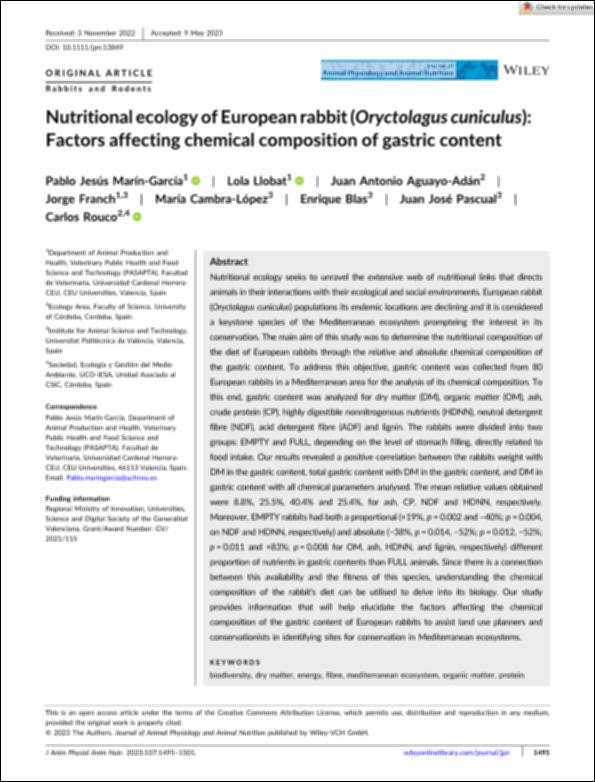Please use this identifier to cite or link to this item:
http://hdl.handle.net/10637/16071Nutritional ecology of European rabbit ("Oryctolagus cuniculus"): factors affecting chemical composition of gastric content
| Title: | Nutritional ecology of European rabbit ("Oryctolagus cuniculus"): factors affecting chemical composition of gastric content |
| Authors : | Marín García, Pablo Jesús Llobat Bordes, Lola Aguayo Adán, Juan Antonio Franch Dasí, Jorge Cambra López, María Blas, Enrique Pascual, Juan José Rouco, Carlos |
| Keywords: | Nutrición animal; Animal nutrition; Conejos; Rabbits |
| Publisher: | John Wiley & Sons |
| Citation: | Marín García, P.J., Llobat, L., Aguayo Adán, J.A., Franch, J., Cambra López, M., Blas, E., Pascual, J.J. & Rouco, C. (2023). Nutritional ecology of European rabbit ("Oryctolagus cuniculus"): factors affecting chemical composition of gastric content. Journal of Animal Physiology and Animal Nutrition, vol. 107, i. 6 (nov.), pp. 1495 - 1501. DOI: https://doi.org/10.1111/jpn.13849 |
| Abstract: | Nutritional ecology seeks to unravel the extensive web of nutritional links that directs animals in their interactions with their ecological and social environments. European rabbit (Oryctolagus cuniculus) populations its endemic locations are declining and it is considered a keystone species of the Mediterranean ecosystem prompteing the interest in its conservation. The main aim of this study was to determine the nutritional composition of the diet of European rabbits through the relative and absolute chemical composition of the gastric content. To address this objective, gastric content was collected from 80 European rabbits in a Mediterranean area for the analysis of its chemical composition. To this end, gastric content was analyzed for dry matter (DM), organic matter (OM), ash, crude protein (CP), highly digestible nonnitrogenous nutrients (HDNN), neutral detergent fibre (NDF), acid detergent fibre (ADF) and lignin. The rabbits were divided into two groups: EMPTY and FULL, depending on the level of stomach filling, directly related to food intake. Our results revealed a positive correlation between the rabbits weight with DM in the gastric content, total gastric content with DM in the gastric content, and DM in gastric content with all chemical parameters analysed. The mean relative values obtained were 8.8%, 25.5%, 40.4% and 25.4%, for ash, CP, NDF and HDNN, respectively. Moreover, EMPTY rabbits had both a proportional (+19%, p = 0.002 and –40%; p = 0.004, on NDF and HDNN, respectively) and absolute (−38%, p = 0.014, –52%; p = 0.012, −52%; p = 0.011 and +83%; p = 0.008 for OM, ash, HDNN, and lignin, respectively) different proportion of nutrients in gastric contents than FULL animals. Since there is a connection between this availability and the fitness of this species, understanding the chemical composition of the rabbit's diet can be utilised to delve into its biology. Our study provides information that will help elucidate the factors affecting the chemical composition of the gastric content of European rabbits to assist land use planners and conservationists in identifying sites for conservation in Mediterranean ecosystems. |
| URI: | http://hdl.handle.net/10637/16071 |
| Rights : | http://creativecommons.org/licenses/by/4.0/deed.es Open Access |
| ISSN: | 0931-2439 1439-0396 (Electrónico) |
| Issue Date: | Nov-2023 |
| Center : | Universidad Cardenal Herrera-CEU |
| Appears in Collections: | Dpto. Producción y Sanidad Animal, Salud Pública Veterinaria y Ciencia y Tecnología de los Alimentos |
Items in DSpace are protected by copyright, with all rights reserved, unless otherwise indicated.


